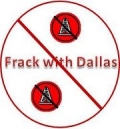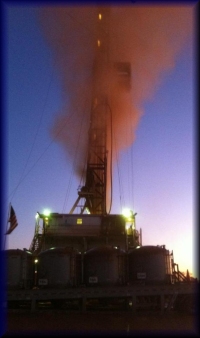 |
 |





 |








 |
    |
Over the last few years much more has been learned about the harmful effects of hydraulic fracturing in terms of environmental damage and associated health risks. Two things that are absolutely essential to human, animal and plant survival are clean air and clean water, both of which are often adversely affected by natural gas production. The DFW Metroplex area, which includes 9 counties under the auspices of the EPA's attainment area, has been in a status of non-attainment for many years, which means that our air is far dirtier than is safe or lawful.
The two major contributing factors to bad quality air in DFW are smog and ozone, the latter of which can be good or bad. Good ozone exists at very high altitudes above the earth acting as a barrier against harmful solar radiation and excessive surface heating such as global warming. Bad ozone, caused by burning of hydrocarbons and other chemicals, is found from the surface to an altitude of a few hundred feet above the surface when pollutants emitted by cars, power plants, gas and oil drilling and production activities, industrial boilers, refineries, chemical plants and other sources react chemically in the presence of sunlight. Ground-level and low altitude ozone pollution is a serious health hazard, especially to active children and those with lung diseases such as asthma. Active adults who work or exercise vigorously outdoors have a higher risk than those who are less active. In general, as concentrations of ground-level ozone increase, more and more people experience unhealthy affects such as respiratory inflammation, reduced lung function, compromised immune systems, damage to lung cells, aggravated emphysema and bronchitis, and even permanent lung damage1. With the recent explosive growth of the natural gas industry in North Texas we have seen elevated levels of air pollution from benzene, zylene, ethylbenzene and toluene, collectively known as BTEX, as well as methane, radon and other gases that are released into the atmosphere by the process of drilling and hydraulic fracturing. In many cases, these are leading to increases in health-related problems for citizens living and working within the 9 counties that make up the DFW attainment area. To be sure, natural gas production is hardly the only culprit, but it is one that can easily be controlled by limiting where and how it can be done so as to insure safe operation with minimal environmental impact. The big culprits from natural gas production are nitrogen oxides (NOx) and volatile organic chemicals (VOCs), each of which can be hazardous to human health. NOx refers to NO and NO2. They are produced during combustion, especially at high temperature. These two chemicals are important trace species in Earth's atmosphere. In addition to acting as a main precursor for tropospheric ozone, NOx is also harmful to human health in its own right.2. Nitrogen oxides, especially nitrogen dioxide, are emitted from high temperature combustion. NOx can be seen as the brown haze dome above cities. Nitrogen dioxide is the chemical compound with the formula NO2. It is one of the several nitrogen oxides. This reddish-brown toxic gas has a characteristic sharp, biting odor. NO2 is one of the most prominent air pollutants.3 Volatile organic compounds (VOCs) refers to organic chemical compounds which have significant vapor pressures and which can affect the environment and human health. Although VOCs include both man-made and naturally occurring chemical compounds, it is the anthropogenic VOCs that are regulated, especially for indoors where concentrations can be highest. VOCs are typically not acutely toxic but have chronic effects. Because the concentrations are usually low and the symptoms slow to develop, analysis of VOCs and their effects is a demanding area of medical science. It is often difficult, if not impossible, to legally prove that adverse health effects from VOCs are the direct result of natural gas production. But, indoor VOCs are hardly the only ones of concern. VOCs are an important outdoor air pollutant. In this field they are often divided into the separate categories of methane (CH4) and non-methane (NMVOCs). Methane is an extremely efficient greenhouse gas which contributes to enhanced global warming. Other hydrocarbon VOCs are also significant greenhouse gases via their role in creating ozone and in prolonging the life of methane in the atmosphere, although the effect varies depending on local air quality. Within the NMVOCs, the aromatic compounds benzene, toluene and xylene are suspected carcinogens and may lead to leukemia through prolonged exposure. 1,3-butadiene is another dangerous compound which is often associated with industrial uses.3 There are many other primary and secondary air pollutants that are the result of natural gas production. A thorough discussion of these pollutants and the problems they cause can be found on the website Downwinders at Risk in the section titled Air 101. A report by Dr. Al Armendariz, PhD., formerly of the Department of Environmental and Civil Engineering at Southern Methodist University and currently serving as the Region 6 Administrator of the US Environmental Protection Agency (EPA), gives an objective and scientific view of the problems facing the DFW Metro area resulting from natural gas well drilling and production activities. The report can be viewed HERE. The EPA proposes to reclassify the DFW area from a moderate nonattainment area to serious nonattainment area for Ozone4. The public will have 30-days to comment after the proposal is published in the Federal Register. The area failed to attain the 1997 8-hour ozone standard. The DFW area includes nine counties: Collin, Dallas, Denton, Ellis, Johnson, Kaufman, Parker, Rockwall, and Tarrant counties. Read the proposal HERE According to an EPA report, "Natural gas plays a key role in our nationís clean energy future and the process known as hydraulic fracturing is one way of accessing that vital resource. But there are compelling reasons to believe that hydraulic fracturing may impact ground water and surface water quality in ways that threaten human health and the environment, which demands further study. To address those concerns and strengthen our clean energy future, a budget has been proposed to fund a comprehensive scientific study of hydraulic fracturing and EPA is working with Congress to start that study as soon as possible." Detailed information about the work being undertaken by the EPA can be found HERE. Unhealthy air adversely affects us all. It causes myriad health problems that require medical treatment, hospitalization, increased costs for individuals and insurance companies, short-term and long-term health and medical problems, early death and other human-related problems. It also results in cities being less attractive to businesses seeking to relocate or remain in a city with poor air quality, and it discourages tourism as visitors avoid unhealthy air, as was the case with the recent summer Olympics in China, where automobiles were banned from the area for a period of weeks before the games began to allow time to clear the air because some athletes were considering boycotting the games to avoid health-related problems caused by smog and ozone pollution. The issues of severe air contamination are reason enough to limit natural gas production everywhere unless and until proven safe methods of extraction and production can be developed. It is especially important to limit production in major urban areas where large population densities expose a greater number of people in the immediate vicinity of well sites and pipelines, the latter of which are known to leak air contaminants from valves and couplings due to inefficient design flaws or failure to maintain operational integrity over time. More importantly, it is essential that we develop clean, sustainable, renewable energy resources that replace the diminishing availability of fossil fuels that have served us well for a century or more, but which today are creating almost as many problems as they are providing benefits. |
1 Green Dallas 2 DFW Non-attainment 3 4 DFW Non-attainment  |